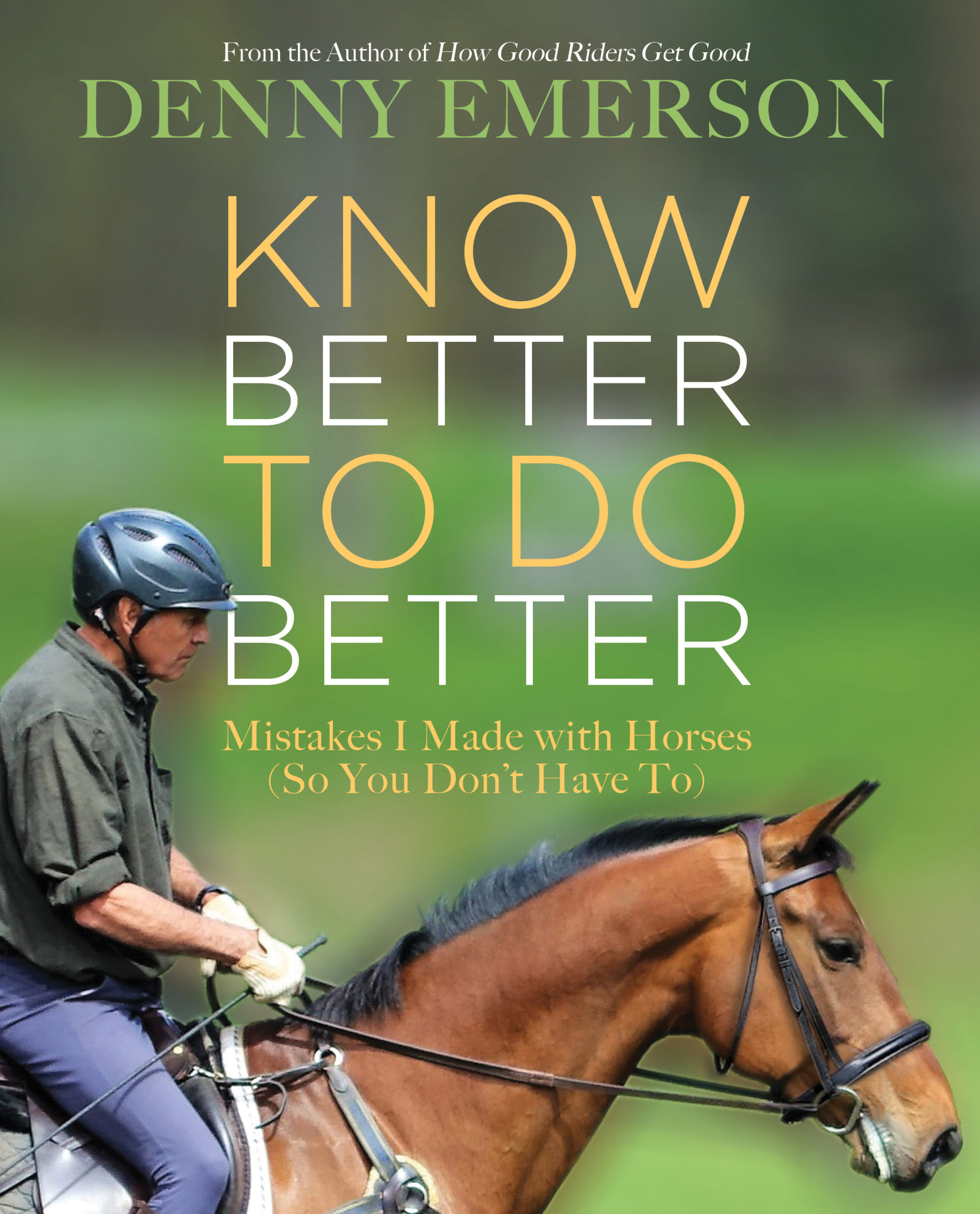In this excerpt from his book Know Better to Do Better, renowned horseman Denny Emerson points out a few of the major mistakes we tend to make when training horses.
 Denny riding. Photo by May Emerson.
Denny riding. Photo by May Emerson.
When training horses, “pretty good” needs to be seen as “good,” and “quit while you’re ahead” should be everyone’s motto.
It is so easy to grind on a horse, to make the horse do something, perform a specific movement, then do it again, and again, and again, all the way to frustration, fatigue, failure, and despair.
We see this every day. Heck, we do this every day. Perfection is the curse of the perfectionist. “Practice doesn’t make perfect. Perfect practice makes perfect.” How often have we had this saying shoved down our throats? As if to hear something enough times somehow makes it true.
The Curse of Perfection
Walk-to-canter, canter-to-walk transitions are hard, so this is a good example. The horse inverts in the upward transition, say, or takes too many trot steps in the downward transition. So it’s not good enough. So we do it again. The horse does it sort of okay. But, no, sort of okay is not good enough. Do it again. Now the horse is starting to get a little worried. Or tired. Or worried and tired. So he gets “resistant.” Now, by God, it’s really not good enough. So we do it again. And once more.…
See where this is going? It is going to hell in a hand basket, that’s where it’s going. It can now only end badly, with a mentally and physically fried horse and an angry and frustrated human.
If we had let the “pretty good” equal good, and quit with that, we’d have been so far ahead. We could have ended with a calm horse, not one who feels as though he has been put through the wringer.
Many days of “pretty good” start to add up to quite good indeed. Grinding to perfection gives the opposite result. It’s a hard lesson for many riders to learn. I wish I had learned it about 40 years sooner.
Getting Mad at a Horse
We’ve all watched it. If we were bluntly honest, most of us have done it. The “it” in question is losing our temper with a horse. Some riders almost never get exasperated enough to get rough with a horse, and for some riders, getting into “World War III” is something that happens just about every time they ride.
If getting angry enough to get rough with a horse just never happens in your situation, consider yourself one of the fortunate ones. You can probably just skip this entire section. But most of us are not that saintly, and one way to alleviate the adversarial struggles that leave both rider and horse “fried”—upset, scared, or angry—is to try to figure out why people get mad at horses.
I think we have to acknowledge that some people are just angry. People who carry around lots of anger get into it with other people, with their family members, with their dogs, while driving their cars, at work—and getting mad at a horse is just one more manifestation of that deeply brewing hostility. These are scary people, to be avoided as much as possible, because the anger within bubbles near the surface and it doesn’t take much for that anger to lash out at whatever or whomever happens to do anything to provoke it. If one of these angry people owns horses, trains horses, runs a stable, teaches riding, shoes horses, or has any interactions with horses or the people around those horses, it’s pretty much guaranteed to be a tense, unhappy barn or farm.
Then there are those who just don’t “get it” that horses are flight animals who don’t like loud noise, quick movement, abrupt handling, being kicked, yanked, chased, admonished, and punished for “bad” behavior. People who are sort of clueless about how to behave around horses make horses nervous and flighty and reactive. Then, when the horse does get reactive, the clueless non-horse people often tend to chastise the horse for the behavior that they caused in the first place.
Some people get angry and rough because they are scared. We see this scenario most frequently with riders who have horses that are “too much horse” for their ability and confidence level. The rider trots down the road, and the horse spooks at a mailbox. Yank, spur, “Don’t be a brat!” yells the nervous rider. The horse feels the spur, feels the yank, hears the sharp yell. Is he going to calm down? No way. He’s going to get more nervous. This scares and provokes the rider even more. Her “aids” get more abrupt and sharp. The horse gets more upset. You don’t have to be Albert Einstein to see where this is headed.
Some people get angry and rough when they think that the horse they are riding is being willfully disobedient. These riders say things like, “He knows what I want him to do, but he just won’t do it.” Or things like, “This horse is being a pig.” Or things like, “My horse is such a jerk.” The list goes on.
The reality, almost always, is that the horse doesn’t understand what the rider wants, hasn’t been trained to perform the requested task, hasn’t had the aid applied correctly, or isn’t strong enough to do what the rider wants.
It all starts with the rider saying, “My horse won’t do what I want.”
 This excerpt from Know Better to Do Better by Denny Emerson is reprinted with permission from Trafalgar Square Books (www.HorseandRiderBooks.com).
This excerpt from Know Better to Do Better by Denny Emerson is reprinted with permission from Trafalgar Square Books (www.HorseandRiderBooks.com).
